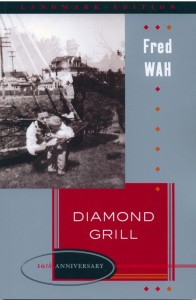
Fred Wah‘s “biofictional” novel, Diamond Grill captivates Wah’s memories growing up as a mixed raced Canadian, and his family’s history. The novel explores such themes as family, culture, race, and belonging, as well as how these factors affect his sense of identity. It is the structure of the book that exemplifies his personal struggle and his families collective struggle with identity. Wah dedicated the book “to Fred, Connie and Ethal. For family.” this dedication is evident in the way he not only writes the novel but structures it. The characters receive little introduction, if any because Wah is writing the book not with the audience in mind but rather for himself and his family. It is structured as 144 short – often one page chapters, that mix up the timeline and story, each page reflecting a different memory or thought. Through the collection of short isolated anecdotes Wah attempts to understand his father’s life, in order to come to terms with his own identity. Unlike more conventional biographies, Diamond grill mixes up separate story lines, recipes, descriptions and family histories that together form a biography representative of Wah’s life. It would seem that the disorderly nature of the “biotext” reflects Wah’s feelings of confusion, as he comes to term with his racial identity.
Wah’s novel is not only a reflection of his own life and struggles, but in the larger picture a commentary on Canadian society. Ultimately his experience of racism from other people as well as his internalized racism is a result of how society marginalizes people based on their race. Fred grew up in the fifties in small town Nelson BC, where racism and prejudice towards Chinese people was widespread. Wah, who is 1/2 Swedish, 1/4 Chinese, 1/8 Irish and 1/8 Scottish, discusses his struggle with his identity as other people tried to tell him what he was. He discusses how when filling out a form in school that asked what his racial origin was, “[he] thought well this is Canada, I’ll put down Canadian. But the teacher said no Freddy you’re Chinese, your racial origin is Chinese…” (53). Wah continues by saying how in the school yard the Chinese kids though of him as foreigner, and so he ended up playing against them since he was “white enough to play on the winning team.” (53). It is this back and forth of being told by people that he was Chinese, or being considered white that caused Wah to be unsure of his identity. He was constantly being categorized, and judged by society, which as a result lead him to not feeling accepted.
 Wah further discusses this in the documentary film Between: Living in the Hyphen which was produced in 2004. This recent film exemplifies how racsim is still very affluent in Canada. The seven mix raced Canadians (including Fred Wah ) that are featured in this film express having felt a lack of belongingness in what was described by one of the individuals as “an either or world.” Both Diamond Grill and Between: Living in the Hyphen exemplify how society treats people of mixed race, marginalizing, and making someone who isn’t “pure” feel like a “resident alien, living in the hyphen.” (Wah 53)
Wah further discusses this in the documentary film Between: Living in the Hyphen which was produced in 2004. This recent film exemplifies how racsim is still very affluent in Canada. The seven mix raced Canadians (including Fred Wah ) that are featured in this film express having felt a lack of belongingness in what was described by one of the individuals as “an either or world.” Both Diamond Grill and Between: Living in the Hyphen exemplify how society treats people of mixed race, marginalizing, and making someone who isn’t “pure” feel like a “resident alien, living in the hyphen.” (Wah 53)

I am grateful for the depth of understanding I have Drift Boss gained through your insightful writing.